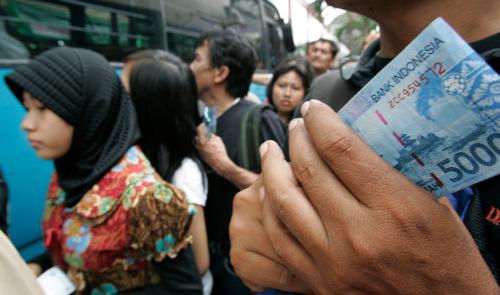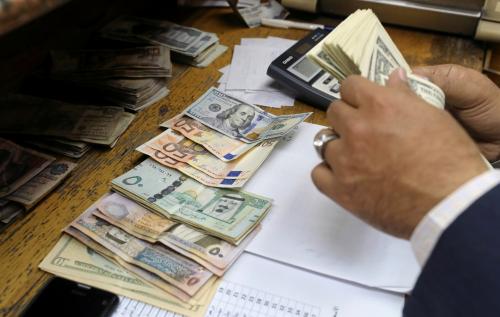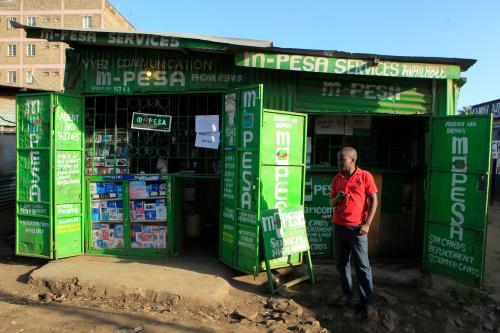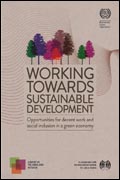On August 4, Brookings will hold an event and live webcast to discuss the findings of the newly released 2016 Financial and Digital Inclusion Project (FDIP) Report. Follow the conversation on Twitter using #FinancialInclusion. Feedback on the report is welcomed at [email protected].
Utilizing quality, affordable formal financial services effectively enables individuals to save for the future, invest in their livelihoods and families, and protect themselves in the case of financial emergencies. At the macroeconomic level, financial inclusion provides opportunities to promote economic growth, reduce income inequality, and combat poverty.
Yet while the economic and societal benefits are evident, achieving financial inclusion is a considerable undertaking that requires significant national-level commitment from government officials, financial service providers, telecommunications bodies, retailers, and other nonbank entities such as post offices. Moreover, advancing access to formal financial services is a necessary, but not sufficient, ingredient for financial inclusion, as a thorough understanding of appropriate financial services and products is needed to leverage them in a way that promotes financial health.
Globally, there has been tremendous progress in promoting inclusive finance: Between 2011 and 2014, financial exclusion declined by 20 percent globally. Yet further efforts are needed to promote access to and usage of formal financial services among the remaining 2 billion adults without formal financial accounts. The second annual Brookings Financial and Digital Inclusion Project (FDIP) report assesses a wide array of geographically, politically, and economically diverse countries to identify areas of strength and opportunities for growth with respect to the acceleration of financial inclusion. As in the 2015 FDIP Report, the FDIP team evaluates four dimensions of financial inclusion: country commitment, mobile capacity, regulatory environment, and adoption of traditional and digital financial services. Below we highlight several of the central enhancements to and findings from the 2016 report.
What is new in the 2016 FDIP Report?
The 2016 FDIP Report builds upon the 2015 report findings in three key ways. First, the 2016 report amplifies the geographic diversity of the FDIP country sample by adding five new countries: the Dominican Republic, Egypt, El Salvador, Haiti, and Vietnam. The report features detailed overviews of the financial inclusion landscape in these five countries, as well as updates surrounding financial inclusion developments in the 21 countries included in the 2015 FDIP Report.
Second, the 2016 report features a number of enhancements to the scorecard metrics that reflect our heightened focus on the usage and quality dimensions of financial inclusion. For example, the new metrics feature an indicator examining financial consumer protection frameworks, as well as an indicator assessing the frequency of account withdrawals at financial institutions. More information on the scorecard metrics is available in the “Methodology” section of the 2016 FDIP Report, and you can view all the 2016 FDIP scores here.
Third, the report hones in on the financial inclusion challenges facing women, refugees, and under-resourced migrants. As noted in our previous post on the gender gap in financial inclusion, women worldwide remain disproportionately excluded from the formal financial system. Moreover, a June 2016 report published by the United Nations High Commissioner for Refugees found that 65.3 million individuals globally were forcibly displaced by the end of 2015—the highest number recorded since the aftermath of World War II.
The global gender gap in financial inclusion, as well as the staggering number of individuals affected by war, persecution, and other forms of conflict and violence, underline the need to find viable ways to ensure women, refugees, and other displaced and marginalized populations have access to the financial resources they need to ensure the well-being of themselves and their families.
What are some of the key findings from the 2016 FDIP Report?
The 2016 report offers good news regarding the global financial ecosystem: Many countries from across the income and geographic spectrum are making progress toward their financial inclusion goals.
For example, on the country commitment side of the 2016 scorecard, countries such as the Philippines have published national financial inclusion strategies. In terms of mobile capacity, El Salvador earned the highest score among the five new FDIP countries, boosted by robust levels of unique subscribership and 3G network coverage, as well as an array of mobile financial service offerings. On the regulatory environment side, Peru officially launched the first fully interoperable mobile money platform, BiM, in February 2016. With respect to adoption of formal financial services, the Dominican Republic earned the highest score among the five new FDIP countries.
To further expand and accelerate access to and usage of affordable, quality financial services, the 2016 FDIP Report highlights four priority areas that warrant additional action moving forward:
1) Establishing specific, measurable financial inclusion targets
Quantifiable goals can drive country commitments and policy changes and help policymakers and non-government entities assess progress toward financial inclusion. Considerable opportunities for growth with respect to instituting concrete targets remain; about one-third of FDIP countries have not yet developed publicly available, quantifiable financial inclusion goals.
2) Collecting and analyzing data relevant to financial access and usage, particularly among underserved groups
For a number of key issues in financial inclusion, data are often limited. Examples of these issues include the frequency of formal financial account usage (particularly regarding digital financial services), consumer confidence in formal financial services, and the costs of utilizing formal financial services. Without consistent, comparable data across countries, it is challenging for researchers and other financial inclusion stakeholders to identify what approaches to financial inclusion are working, and why.
3) Advancing regulatory changes designed to facilitate financial inclusion
Regulations should promote a level playing field for financial service providers and ensure adequate consumer protection for customers. Facilitating the entry of diverse service providers into the financial ecosystem through enabling and inclusive regulation can promote competition, reduce costs, and advance access to financial services in rural and other underserved areas.
4) Enhancing financial capability among consumers
Improving access to formal financial services requires ensuring that consumers are aware of the suite of services available to them and find value in actually leveraging those services. Government leaders, non-government entities, and financial service providers should work together to implement policies and initiatives that recognize the importance of financial capability through targeted data collection and capacity-building programs.











Commentary
New Brookings report highlights advances in financial and digital inclusion
August 4, 2016